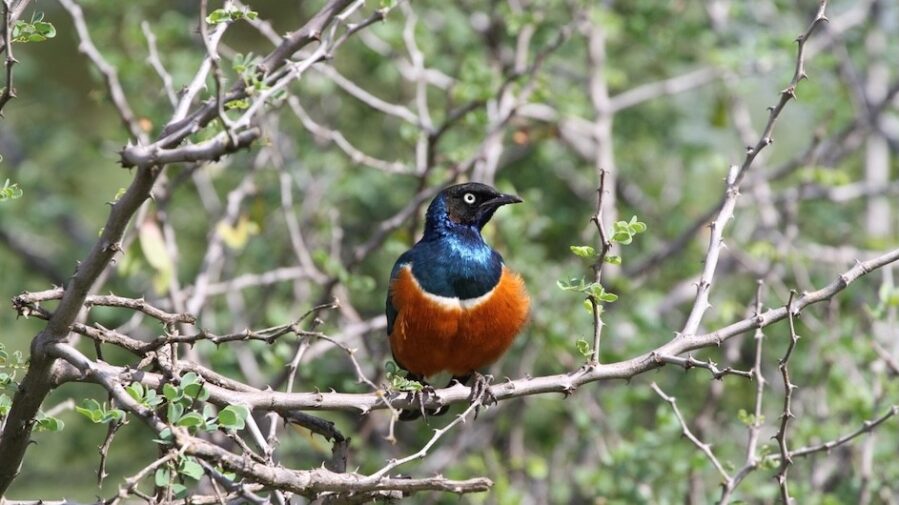A 20-year study published in Nature demonstrates that birds form long-term, reciprocal relationships that closely resemble human friendships. Columbia University researchers discovered that African starlings develop cooperative partnerships with both relatives and non-relatives, challenging long-held assumptions about animal social behavior.
Two Decades of Observation Reveals Hidden Patterns
The extensive research, led by Alexis Earl and Professor Dustin Rubenstein, tracked thousands of interactions between hundreds of superb starlings (Lamprotornis superbus) in East Africa from 2002 to 2021. Their findings revealed something remarkable – the birds consistently swap roles between “helpers” and “breeders” over time, creating reciprocal relationships that benefit both participants.
“Starling societies are not just simple families, they’re much more complex, containing a mixture of related and unrelated individuals that live together, much in the way that humans do,” Rubenstein explained in the study published on May 7, 2025.
This discovery represents a significant shift in our understanding of animal cooperation. While scientists have long known that animals help blood relatives to promote their genetic legacy, the evidence for non-family reciprocal relationships has remained elusive – until now.
Reciprocity Takes Time to Detect
The research team meticulously documented over 12,000 helping events by 563 helpers at 410 nests across 40 breeding seasons. By combining behavioral observations with DNA analysis, they could distinguish between family-based assistance and reciprocal relationships between unrelated birds.
The data revealed that while starlings do preferentially help relatives, they also frequently assist specific non-relatives, even when family members are available to help. What’s more surprising is that these partnerships persist over many years, with birds taking turns supporting each other.
Why did it take two decades to discover this pattern? The study found that while kinship-based helping becomes statistically evident after just three breeding seasons, detecting reciprocal relationships required at least 27 seasons of observation. This explains why such behavior has remained hidden from researchers conducting shorter-term studies.
Adapting to Harsh Environments Through Cooperation
The superb starlings live in the challenging, unpredictable savannahs of East Africa – an environment where cooperation can mean the difference between survival and death. The study suggests that these friendship-like bonds may be particularly advantageous in such harsh conditions.
In this demanding landscape, starling groups increase their size and stability by admitting unrelated immigrants who are allowed to breed almost immediately. These non-related birds then form reciprocal helping relationships with existing group members, strengthening the entire community.
“Many of these birds are essentially forming friendships over time,” noted Rubenstein. “Our next step is to explore how these relationships form, how long they last, why some relationships stay robust, while others fall apart.”
Implications Beyond Birds
The findings raise an intriguing question: How common might these friendship-like bonds be throughout the animal kingdom? Rubenstein’s team has studied social behavior in diverse species worldwide, including shrimp, wasps, beetles, mice, and lizards.
“I think this kind of reciprocal helping behavior is likely going on in a lot of animal societies, and people just haven’t studied them long enough to be able to detect it,” Rubenstein said.
The research provides fascinating parallels to human social structures. Like humans, starlings maintain strong family bonds while also forming meaningful relationships outside their immediate family circle. These non-family connections appear to be just as important for group stability and individual success as kinship ties.
Key Findings from the 20-Year Study:
- Starlings form reciprocal helping relationships with both relatives and non-relatives
- Birds regularly switch between “helper” and “breeder” roles over the years
- Non-family helping occurs even when relatives are available to assist
- Reciprocal helping relationships require at least 27 breeding seasons to detect
- After 40 breeding seasons, reciprocal help proved to be a stronger predictor of helping behavior than kinship
- Both male and female immigrant birds showed higher rates of reciprocal helping
As researchers develop more sophisticated techniques for long-term observation, we may discover that friendship-like bonds are far more widespread in the animal kingdom than previously thought. The starling study suggests that many animal societies may operate with levels of social complexity that more closely resemble our own than we’ve realized – we just haven’t been watching long enough to see it.
If our reporting has informed or inspired you, please consider making a donation. Every contribution, no matter the size, empowers us to continue delivering accurate, engaging, and trustworthy science and medical news. Independent journalism requires time, effort, and resources—your support ensures we can keep uncovering the stories that matter most to you.
Join us in making knowledge accessible and impactful. Thank you for standing with us!

